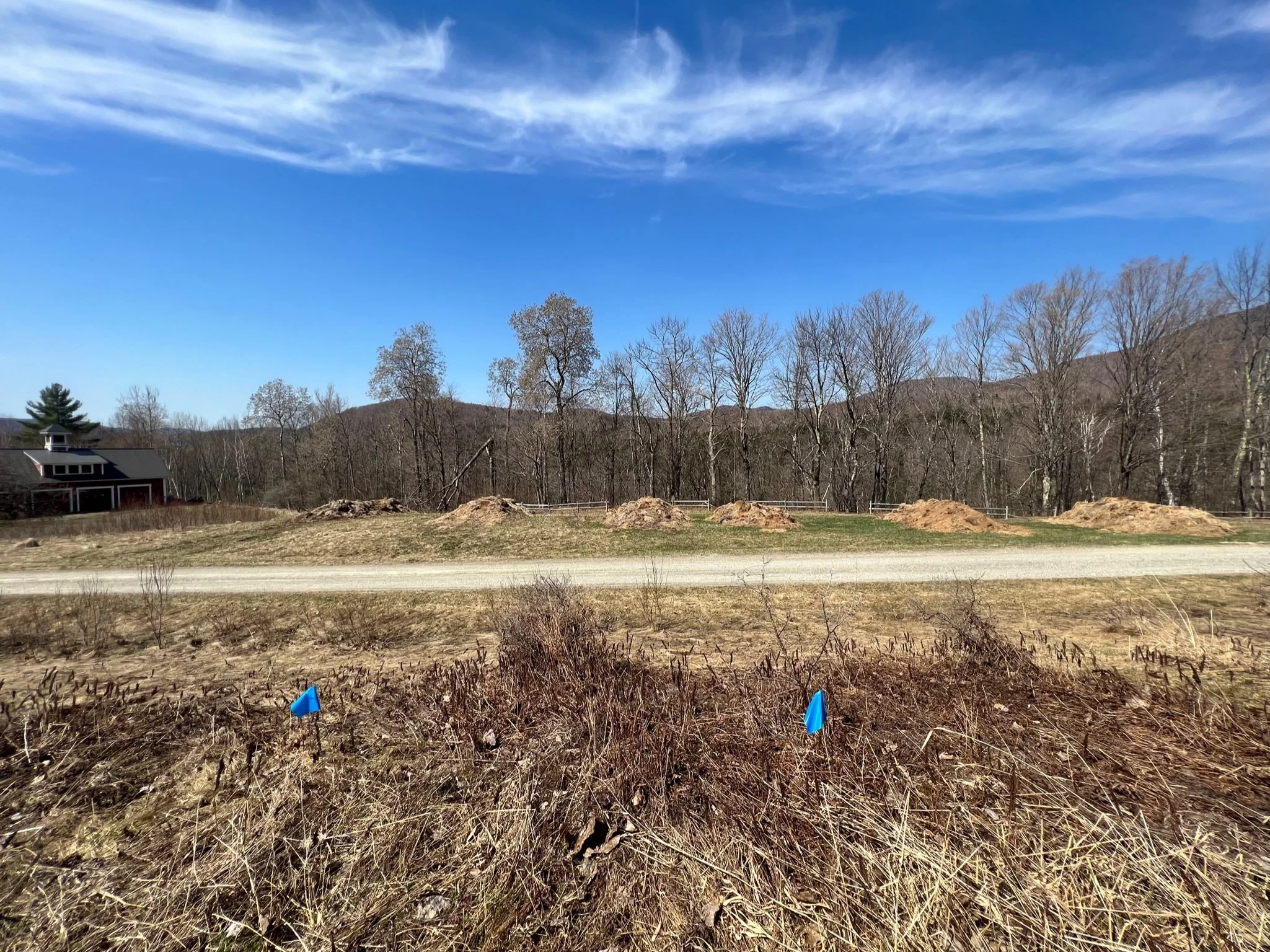HOW A PLANT-CENTERED FARM, WILDLIFE REFUGE AND DUCK SANCTUARY WORKS WITH SANCTUARY BEDDING & COMPOST—AS PART OF AN ONGOING, MUTUALISTIC PROCESS.
Enjoy this small spring tour of our first 2-year old piles—the stage at which we can grow squashes throughout the standing pile. Pictured below the video, you can see different-aged windrows in different locations, just to get a sense of the amount of materials we handle in any given year.
Followed by an evolution of our process in coming years, when we switched to green pine sawdust as the main bedding material, with smaller amounts of hay. How to place the piles where they will enhance the ecosystem and perhaps remediate damaged soils? How to properly time the introduction of mushroom spawn to myceliate the pile, to use the cellulose as a food for edible mushrooms, to accelerate the complexity and conversion of the pile into soil? Then, how to discover which plants are capable of using the nutritents at what time and how to create and preserve flavor and nutrition with what grows within?
Our goal is to understand the pile itself as its own ecosystem, to learn about the different beings who live within it: redworms, snakes, toads, rodents, bees. When the pile has decomposed sufficiently, we disturb it by planting small pockets with vining squashes. We sprout seeds and then plant strategically after a rain when there’s sufficient residual moisture in the pile to make any further watering unnecessary. We do the same thing the following year, but we disturb the pile more, with our tractor bucket, to flatten it out further. The last stage might involve flattening the pile even more to blend it with the surrounding soil grade, followed possibly (and depending on location), with spreading out a silage tarp and using the area repeadetly as a large ,no-till growing area. This would be to leverage all the effort and time of decomposition in place to establish a plantable area (instead of tillage, etc.).
We locate piles where the soil has been disturbed or stripped away in the past—as an act of restoration. So that the added biology can potentially serve to deepen and revive the soil. We also choose areas that are close to the farm buildings, to control the costs of transporting the bedding, and to enable us to keep an eye on developing plants.
We feed the squash leaves and vines to our sanctuary duck flock—they are a favorite food! We harvest the hull-less pumpkin seeds and some of the blossoms for our own use, and we feed the pumpkin flesh to the ducks and to our dogs (and sometimes to us).
The compost mound can also support mushrooms like king stropharia, blewetts or almond agaricus—and any number of wild mushroom species that inoculate the pile. Introducing mycelia at strategic times will enhance the mycorrhizal life in the soil, as well as accelerate nutrient cycling.
We also use the compost in our own potting mix to start vegetable plants. We’ve placed small mounds of compost in between the tree rows in our food forest, and plan to grow the 3 sisters—corn, beans, and squash—in those mounds.
We import softwood sawdust from local mills and hay from nearby fields—along with organic grain-based feed, granite grit, and specialized waterfowl feed. We challenge ourselves to cycle these precious substances as much as we possibly can to build the life force on our land, honor the energy and lives expended in their production—until such a time when we no longer need them.
A video of this year’s planting of a 2-year old pile. We show king stropharia mushrooms emerging…piles can be deliberately innoculated with stropharia mycelia, Also with blewett and almond agaricus. Stropharia is reliable for us.
King stropharia mushrooms (a choice edible) and newly emerging pumpkins just planted in this 2 year-old pile. (May 2022)
Young sqash plants in a 2-year-old pile, pictured also below.
A 2021 squash grow on a 2-year old pile.
The same pile as the image above, now in year 3, disturbed in May 2022, before planting again with styrian (hulless-seeded) pumpkins. These pumpkins produce seeds that are excellent as a human protein and nutrient source, as they require no hulling.
A 1-year old pile
6-18-month old piles, with a greater proportion of green sawdust. These piles will take longer to break down, but we’re exploring mushroom spores that might work best with them. King Stropharia seems to be a good candidate. Again, the shade provided by adjacent and interspersed plants creates ideal conditions for mushrooms.
A 0-6 month old pile, about to be re-located to age in place.
Sometimes we pile bedding high near and underneath our perennials, then we clear away the mulch and plant pumpkins. This also works well.
We’ve also used the compost to establish no-till garden areas, by spreading cardboard and adding about 4-6” inches of compost on top. This is usually a one-time application in order to transition one ecosystem to another. This allows the soil structure and mycorrhizal network to remain intact. Using sanctuary bedding in this manner helps this conversion.
Redworms rush to inhabit the compost piles and are able to over-winter in the warmer zones toward the middle of the pile whereas they would otherwise perish in the cold. The piles practically become vermicompost, as worm castings create invaluable soil structure and plant health via their humic acids.
Toads hibernate in the compost piles.
This brown snake loves the composting duck bedding.
7 windrows at about 18 months old before planting
The same piles after planting. Maize on the far left piles, pumpkins and squash on all of them, mushrooms on most of them.














